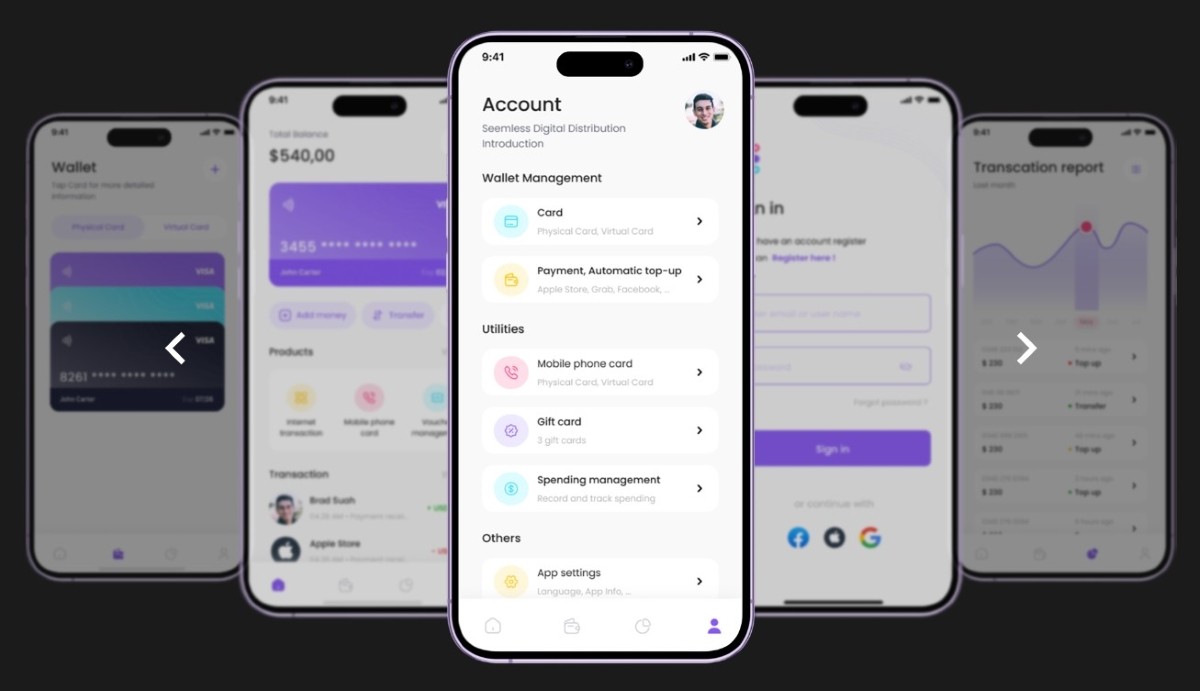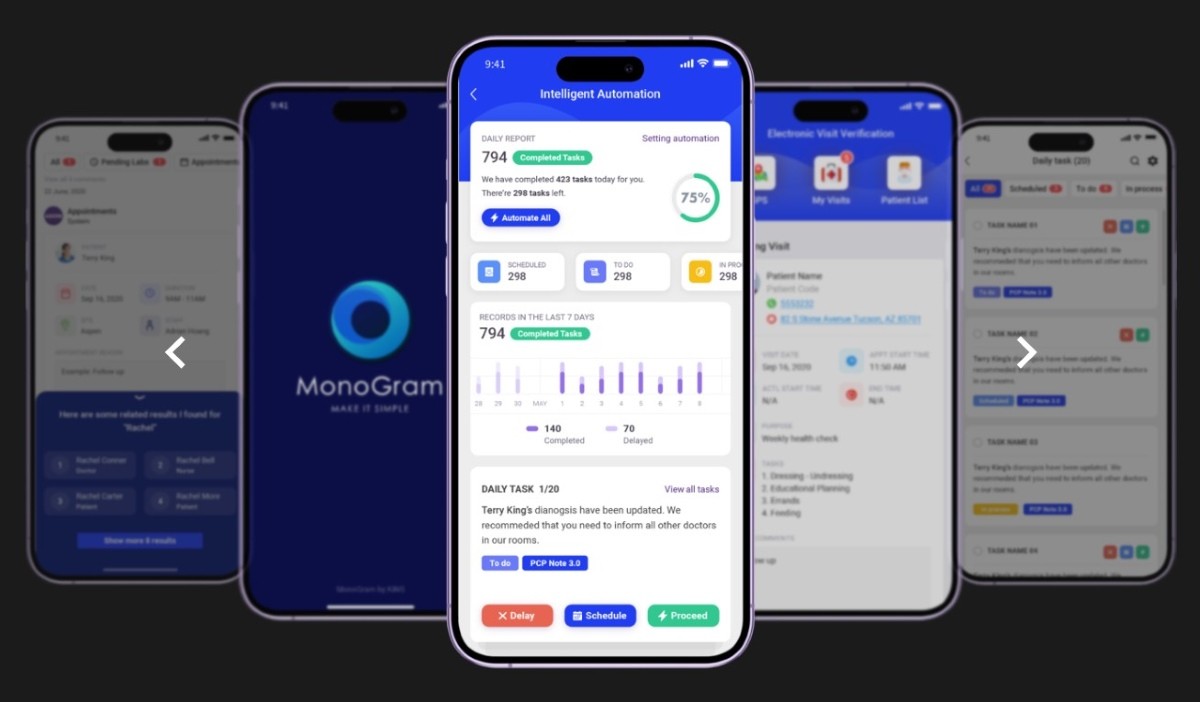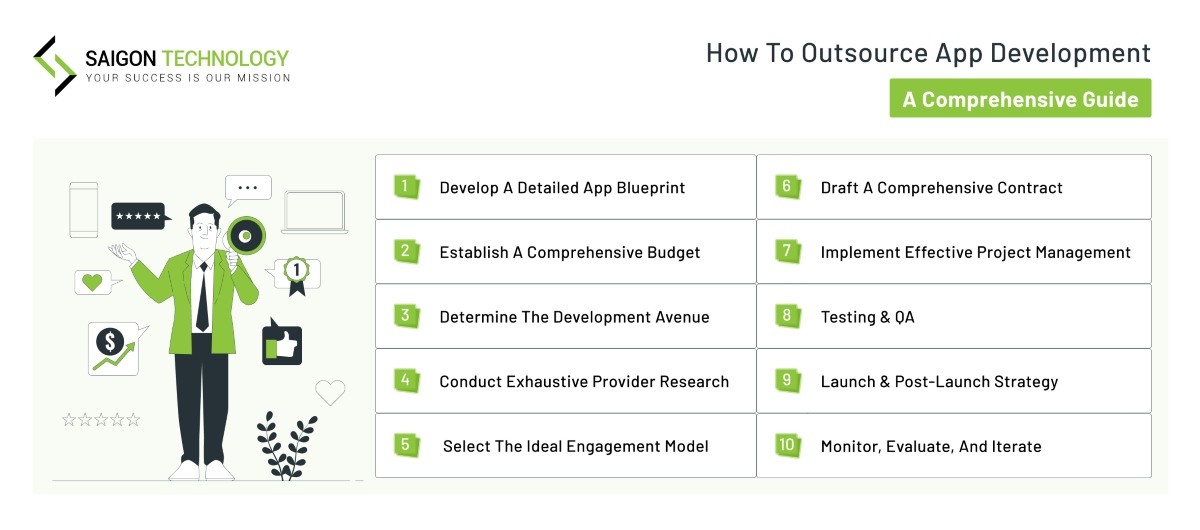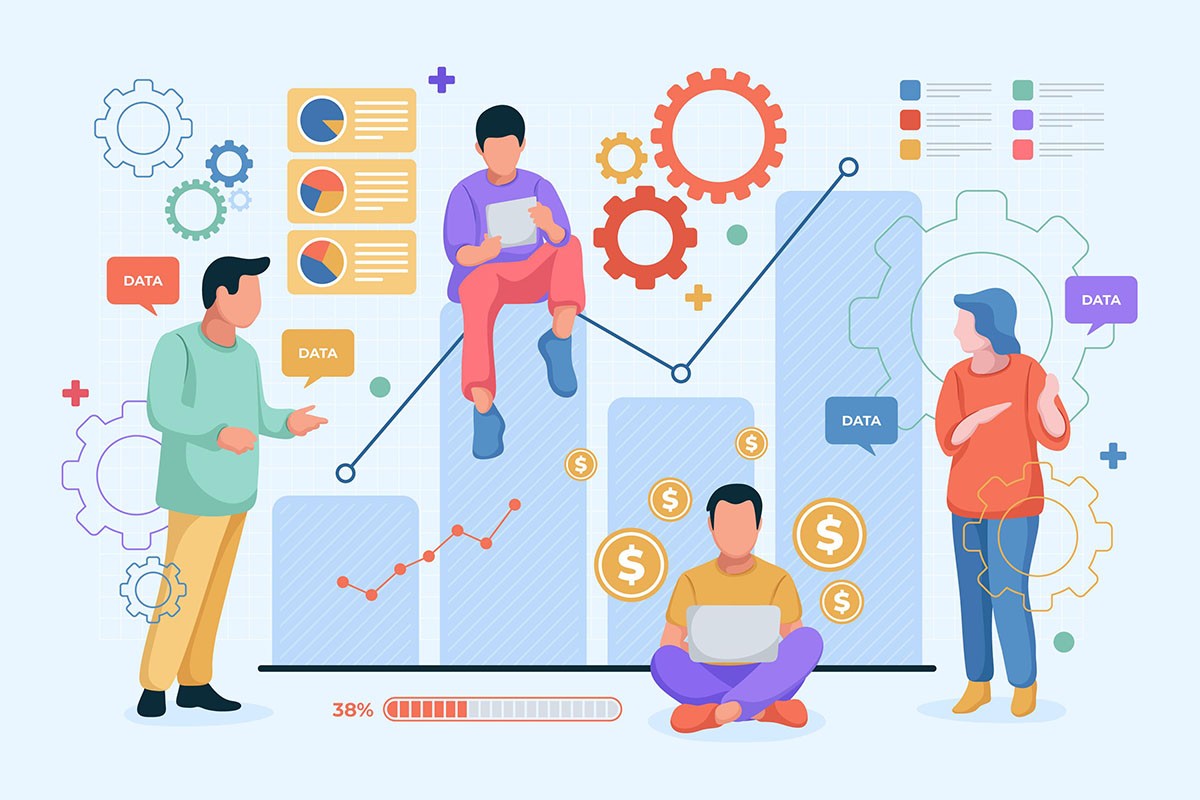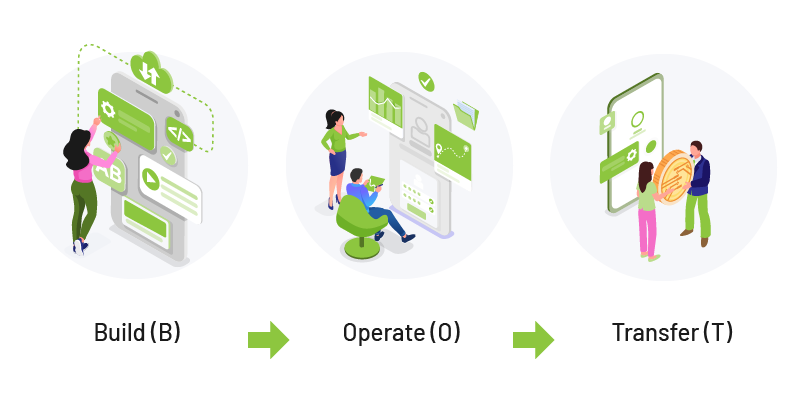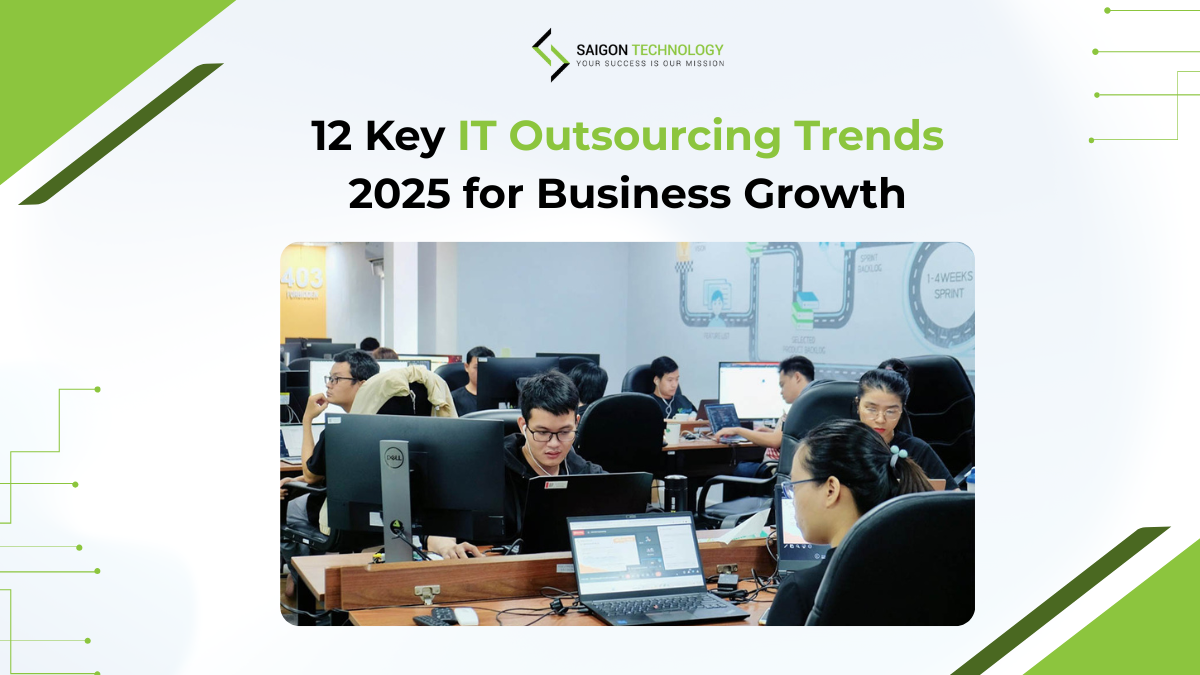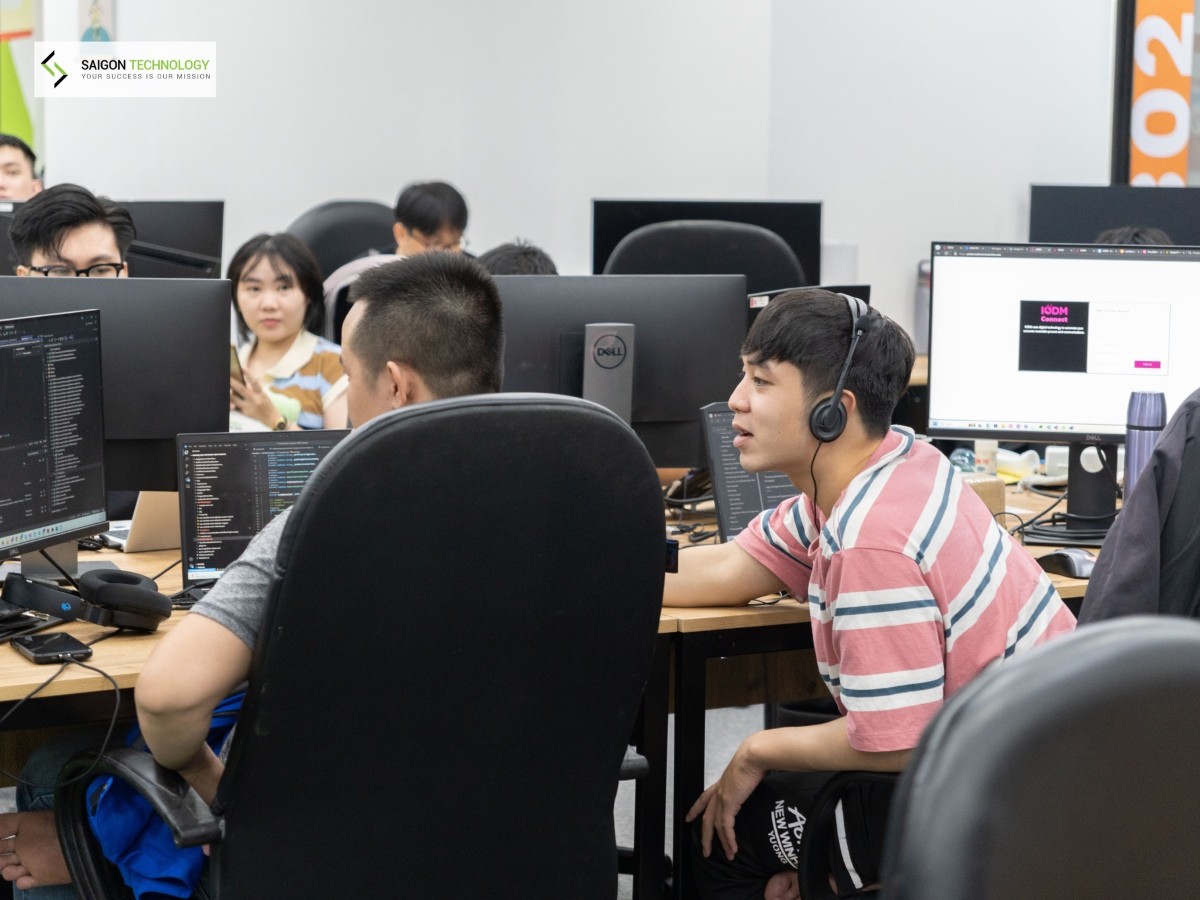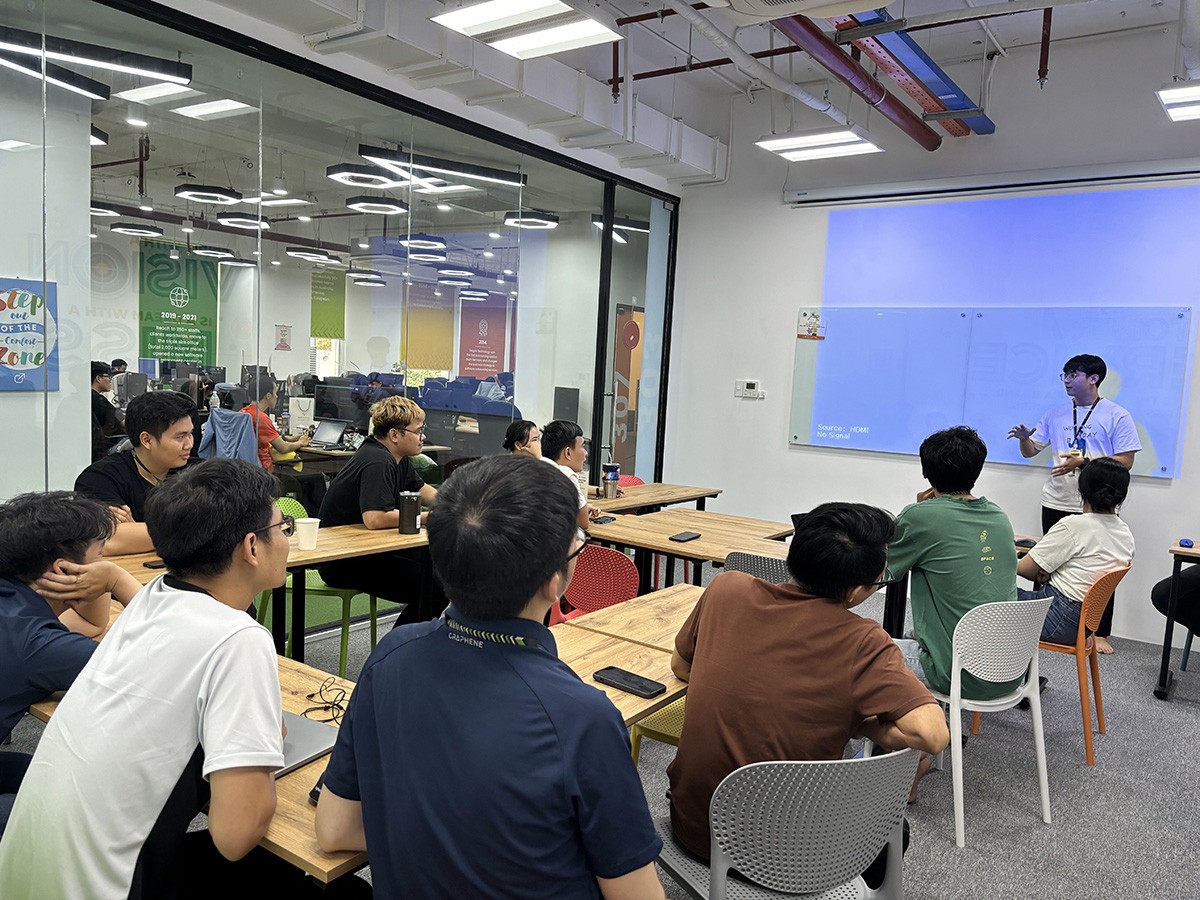In today’s fast-changing digital world, outsourcing mobile app development is not just a trend—it’s essential. Big companies like Alibaba, Google, and WhatsApp have outsourced work to reduce development costs and get top talent. This approach helped these companies grow, improve quality, and stay competitive globally.
Businesses adopting this strategy must have a deep understanding of the outsourcing landscape. In this article, Saigon Technology, a premier provider of mobile app development services, is pleased to offer insights on how to outsource app development. We’ll also highlight key factors that can help you build a strong and effective partnership.
The Outsourcing Mobile App Development Market in 2024
Digital solutions are in high demand, and this surge is fueling rapid growth in the application outsourcing market. According to Statista, the global market size for Application Outsourcing is projected to reach $118.10 billion in 2024. It is expected to grow to $124.10 billion by 2029, at a compound annual growth rate (CAGR) of 1.00% over the forecast period. The United States remains the largest market, expected to generate $42.86 billion in revenue in 2024.
IBM, Accenture, and VMware lead the market, delivering top-tier services at unbeatable prices. Companies are driving this growth by trying to slash costs and tap into a vast pool of skilled workers. Companies outsource app development to experts with a global reach. This lets them focus on their core business activities.
Comparing In-house vs. Outsourcing App Development
Decide between in-house development and outsourcing by considering cost, skills, and scalability. Below, we break down the key differences between these two approaches:
| Criteria | In-house | Outsourcing app |
| Initial Cost | Often higher due to infrastructure setup, hiring, and training expenses. | This is typically cheaper. Businesses pay for the development services. They avoid the costs of maintaining a team. |
| Skill Diversity | Limited to the expertise of the hired team. Can be restrictive for diverse project needs. | Access to a broad spectrum of skills and expertise, ensuring versatility in development. |
| Flexibility | Greater control over team dynamics and immediate alterations to project scope. | The need for changes depends on the app development agreement. They might require renegotiation. But, established firms offer flexible, adaptive models. |
| Resource Availability | You can face constraints. These come from having few team members or needing specific tools and tech. | Companies that outsource development have more resources, tools, and tech. This means that development will not stop. |
| Time to Market | Might be slower initially, especially if the team needs training or tool procurement. | Experts are often faster. This is due to their specialized skills and existing infrastructure. These things speed up the development cycle. |
| Knowledge Retention | Knowledge remains within the company, beneficial for long-term maintenance and iterations. | Knowledge transfer is crucial post- development. Collaborating with reputable firms ensures effective handover and documentation. |
| Focus on Core Competencies | Companies might divert from their core operations to oversee application development. | Companies can focus on their main activities. They can leave app development to outside experts. |
| Scalability | Scaling the team for larger projects might require additional time and investment. | Scaling operations is easier. Outsourcing firms can quickly add resources as needed. |
Whether you develop in-house or outsource app development, the end goal is to create an app that meets user expectations and boosts business. This guide empowers you to make well-informed decisions that align with your business goals.
Reasons to Outsource Mobile App Development
Outsourcing mobile app development offers companies agility, expertise, and cost savings. But what exactly is outsourced app development? It involves outsourcing IT-enabled services to a specialized mobile app firm. This gives businesses access to global experts without a costly in-house team. The 1990s boom in telecom and the internet made global collaboration possible.
“The growth of offshoring of IT-enabled services, although not universally accepted, both to subsidiaries and to outside companies (offshore outsourcing) is linked to the availability of large amounts of reliable and affordable communication infrastructure following the telecommunication and Internet expansion of the late 1990s.” Outsourcing – Wikipedia.
1. Access to Global Talent
Outsourcing app development allows companies to tap into a global pool of skilled professionals. This diversity brings various perspectives, expertise, and innovative solutions. Global best practices will improve your app’s tech and ensure it meets international standards.
2. Significant Cost Savings
Collaborating with an outsourced team reduces costs substantially. Teams dominate infrastructure and personnel costs, freeing companies to allocate resources efficiently.
For instance, outsourcing to nearshore or offshore software development can save a company 40% to 70% in overall costs. Businesses achieve cost-efficiency by slashing labor expenses and overhead, then allocating resources strategically.
3. Faster Time-to-Market
Outsourced mobile app development often involves dedicated teams that can work around the clock. This effort shrinks project timelines, fast-tracks launches, and enables businesses to seize market opportunities quickly.
4. Access to Cutting-Edge Technology
Outsourced app developers are usually at the forefront of technological advancements. By collaborating with these experts, companies can ensure their apps are built with the latest tools and methods. This positions the application as a leader in its field and ready for future changes and growth.
5. Better Business Focus
Businesses build apps by outsourcing development, freeing internal teams to tackle major goals. This frees up in-house resources to work on high-priority initiatives. Outsourcing mobile app development lets teams focus on core activities, boosting growth and innovation
6. Scalability and Flexibility
If market demand surges, outsourced teams can easily adapt by adding new features or beefing up an app’s capabilities. This way, businesses stay competitive. Outsourcing supports long-term success by allowing projects to scale as needed.
7. Streamlined Project Management and Continuous Business Support
Outsourcing app development ensures good project management and smooth operations. It also provides ongoing support post-launch, ensuring a successful project outcome. This approach results in high-quality applications and guarantees long-term performance and maintenance.
Primary Challenges in Mobile App Development Outsourcing
Outsourcing mobile app development yields significant benefits and presents distinct challenges. At Saigon Technology, we don’t just identify these obstacles – we come up with ways to tackle them, so our partners have a smooth experience.
Here are some tips for how to outsource app development. You can succeed by avoiding these common challenges.
1. Communication Gaps and Misunderstandings
One of the biggest challenges in outsourcing is communication. Cultural, language, and time zone differences spark misunderstandings and inevitably delay project timelines. This can affect the overall workflow and hinder project progress if not managed properly.
Solution: Set up open communication channels and convene regular meetings to drive progress. Use tools like Slack, Trello, or Teams to clarify project requirements and expectations.
2. Quality Control and Consistency
Maintaining a high standard of quality is crucial, especially when you outsource mobile app development to remote teams. Inconsistent coding, unclear docs, or ignoring best practices can lower quality.
Solution: Rigorous quality assurance (QA) is ensured by our regular code reviews, comprehensive testing, and strict documentation standards. This will ensure consistency and quality throughout the project lifecycle.
3. Project Management Complexity
Managing an outsourced mobile app project can be complex. This is especially true if it involves multiple teams or a mix of in-house and outsourced resources. Coordination issues, unclear roles, and scope creep can disrupt timelines and budgets.
Solution: Use a well-defined project management method, like Agile or Scrum. Assign a project manager to maintain control and set crystal-clear roles to ensure the project stays organized and on track.
4. Security and Data Privacy Concerns
Sharing sensitive business data and proprietary code when you outsource app development can be risky. Without proper security measures, there can be data breaches, IP theft, or unauthorized access, potentially causing severe financial and reputational damage.
Solution:
Choose a partner with a strong security framework. Here are some key considerations:
Data Processing Agreement (DPA): Ensure that your partner is willing to sign a DPA, which outlines how they will handle and protect your sensitive data in compliance with data protection laws.
Intellectual Property Protection: Make sure there are clear agreements in place regarding IP ownership and protection. This should include clauses that specify how your proprietary code and data will be safeguarded throughout the development process.
Legal and Security Compliance: Enforce non-disclosure agreements (NDAs) and ensure compliance with data protection laws, like GDPR and CCPA, to protect your IP and data. Regular audits and assessments of their security practices can further mitigate risks.
5. Unaligned Expectations and Project Goals
If the client and outsourcing partner misalign, the product may not meet business needs. This often happens due to vague project briefs, unclear specifications, or a lack of iterative feedback.
Solution: Define project goals, document them, and review them iteratively. This will ensure alignment and avoid costly redesigns.
6. Hidden Costs and Budget Overruns
Application development outsourcing reduces expenses, but beware of additional fees that can emerge. Frequent changes, extra feature requests, and delays can blow the budget. This is especially common in cases where there is no clear agreement on the scope and deliverables.
Solution: Create a contract that details costs and procedures for scope changes. Be transparent about any extra expenses to avoid budget overruns.
7. Choosing the Right Development Partner
A reliable outsourcing partner must possess the right skills, experience, and cultural fit. A wrong choice can lead to subpar quality, delays, or a failed partnership altogether.
Solution: To ensure a successful collaboration, do thorough research. Review portfolios and check client references. Prioritize partners with a proven track record in mobile app development outsourcing, like Saigon Technology.
How to Outsource App Development: A Comprehensive Guide
Transform your vision into a market-ready product by outsourcing mobile app development. This guide maps out a precise path for app development success, detailing every strategic step to navigate your journey.
1. Develop a Detailed App Blueprint
Purpose & Vision: Every successful app begins with a well-defined vision. Before you outsource app development, identify your app’s core goals in concise statements and outline the problem it aims to solve. This should include how the app fits into the broader industry landscape and the tangible benefits it will offer to users. Tip: Reference similar successful apps in your industry to clarify your unique value proposition.
Features & Specifications: Create a feature list and define how each one contributes to the app’s value proposition. Consider organizing features into Must-Have, Nice-to-Have, and Future Add-ons categories. When you outsource mobile app development, linking each feature to user needs and industry trends is crucial for alignment. Example: For a fitness app, features like activity tracking and goal-setting reminders should help users stay fit.
User Persona & Journey: Develop detailed user personas to represent your target audience. Understand their pain points, motivations, and expectations. This helps shape the app’s interface and content. Develop user journey maps that pinpoint how users navigate the app, exposing potential friction points from the start. Include visuals or sample journey templates to make this actionable.
2. Establish a Comprehensive Budget
Direct Development Costs: Consider all direct expenses, from planning to deployment. This includes design, coding, testing, and integration costs. Use industry benchmarks for cost estimates (e.g., average cost per hour in Eastern Europe vs. Southeast Asia). Provide data or references on average costs to increase transparency.
Contingency Fund: Set aside 10-15% of the total budget for unforeseen issues. Example: Unexpected fees, scope changes, or integration issues often need additional resources, especially when navigating the complexities of outsourcing mobile app development.
Post-launch Costs: Outline ongoing maintenance, updates, and marketing expenses post-launch. Provide a clear estimate for yearly costs based on industry norms. Consider quoting a source, such as a 2024 report on post-launch costs by Clutch to substantiate the information.
3. Determine the Development Avenue
Service Type: Decide whether to leverage mobile app development outsourcing for the entire project or only specific aspects, such as UI/UX design or QA testing. Example: A small business wants a complete solution. A larger enterprise needs targeted consulting to drive its digital transformation. Create a comparison table that clearly shows which service type is best for each business scenario.
Project Scale and Complexity: Identify whether you’re building a simple MVP or a complex enterprise solution. Explain how this choice impacts timelines, budget, and the selection of development models.
4. Conduct Exhaustive Provider Research
Reputation & Portfolio: Research potential mobile app outsourcing companies by reviewing their portfolios and client feedback. Look for case studies that demonstrate their expertise in your industry. Cite platforms like Clutch, GoodFirms, or DesignRush to find vetted providers with proven track records.
Niche Expertise: Seek vendors with expertise in your specific app category (e.g., healthcare, fintech). This ensures they know your industry’s standard and design needs. For a fintech app, choose a provider with experience in security compliance and payment gateway integration.
Engage in Preliminary Discussions: Discuss the mobile app outsourcing company’s development approach and team structure. Also, check their familiarity with your project’s tech stack. Include a list of sample questions for these discussions to ensure thorough evaluation.
5. Select the Ideal Engagement Model
Project Complexity & Duration: Choose the best engagement model for your project’s size and timeline. Options include Staff Augmentation, Dedicated Teams, Fixed Price, or ODC. Consider whether you prefer onshore, nearshore, or offshore resources based on your project’s complexity and duration.
Flexibility Requirement: If your project may evolve, choose flexible models. Dedicated Teams allow for changes without much re-negotiation.
6. Draft a Comprehensive Contract
Scope and Deliverables:
Clearly define project scope, outcomes, and deliverables. Include a template or checklist to ensure nothing is overlooked. Specify responsibilities, so both parties have a shared understanding.
Milestones & Payments:
Break down payments according to milestones achieved. It’s essential to include an advance payment to secure the commitment of the development team. Create SMART criteria (Specific, Measurable, Achievable, Relevant, Time-bound) for each milestone. This will ensure clarity and accountability throughout the project. Additionally, consider incorporating a money-back guarantee clause to reassure both parties about the quality of deliverables.
Terms and Conditions:
Include clauses for IP protection, NDAs, and dispute resolution. A well-structured service level agreement (SLA) should outline the expectations regarding service quality and performance metrics. Refer to sample contract templates to guide readers in crafting comprehensive agreements that protect their interests
7. Implement Effective Project Management
Choose a Management Tool: Adopt tools like JIRA, Trello, ClickUp, or Asana for tracking progress. Offer a comparison table detailing the strengths and use cases of each tool.
Set Clear Channels: Set guidelines for how and when to communicate, using tools like Slack, Teams, or Zoom. Specify preferred channels for urgent updates and routine check-ins.
Feedback Mechanism: Set up feedback loops using user testing, peer reviews, and retrospectives. Include tips on how to conduct effective feedback sessions.
8. Testing & QA
Internal Testing: Conduct testing during development to catch issues early. Tip: Use automated testing tools like Selenium or Appium for routine tests, and integrate with CI/CD pipelines.
User Acceptance Testing (UAT): Involve a small group of users to test the app’s functionality in real-world scenarios. When you outsource app development, consider asking your development partner to recruit target users or beta testers who fit your personas to provide meaningful feedback.
9. Launch & Post-launch Strategy
Soft Launch: Release to a smaller user base initially. Tip: Use this opportunity to gather early user feedback and refine it before a full-scale launch.
Feedback Loop: Continuously collect and analyze feedback. Implement tools like Google Analytics or Mixpanel to track user behavior and iterate based on insights.
Updates & Maintenance: Schedule regular updates to introduce new features and fix bugs. Cite research on how regular updates improve app retention rates.
10. Monitor, Evaluate, & Iterate
Performance Metrics: Track KPIs like user retention, engagement, and churn rate. Use tools like Firebase Analytics or Amplitude to monitor these metrics.
Continuous Improvement: Don’t wait for major releases to make changes. Use an Agile approach to deliver improvements iteratively based on feedback and performance data.
Outsourcing mobile app development is a journey of collaboration, innovation, and precision. This roadmap will help businesses avoid pitfalls and succeed in their digital transformation.
How Much Does Outsourcing Mobile App Development Cost?
Outsourcing mobile app development saves companies resources and delivers great results. The tech world has undergone a revolution. Cost-effectiveness and global talent acquisition are two significant benefits that have emerged.
However, accurately determining the cost isn’t straightforward, as multiple factors influence pricing. They include regional variations, developer skills, the tech stack, and the hiring model.
Industry benchmarks and surveys from sources like Clutch show that, at $35/hour, the cost to outsource app development is as follows:
– Simple app development cost: $20,000 to $100,000
– Medium-complexity app development cost: $100,000 to $200,000
– Complex app development cost: $200,000 to $300,000+
Key factors shaping pricing levels:
1. Regional Differences
Every region presents unique price points for software development. Countries have different economies, labor markets, and tech. This leads to varying hourly rates for developers. For instance:
Asia:
India, Vietnam, Singapore, and the Philippines are popular for IT outsourcing. The hourly rates range from $30 to $40, making them highly competitive.
Clients should consider challenges, like time zone differences, political stability, and language skills.
Europe:
Western Europe, including tech hubs like Germany and France, typically charges higher rates, averaging $50 to $60/hour.
Meanwhile, Eastern Europe, including Poland and Ukraine, offers a balanced mix of affordability and quality at $45 to $55/hour. The region has strong technical talent and robust IT education systems.
Australia and New Zealand:
These regions maintain robust tech ecosystems with pricing that often mirrors North American standards at $45 to $60/hour. While their costs may be on the higher end, they bring unique advantages, such as cultural alignment and high-quality work.
North America:
As a frontrunner in tech innovation, the US and Canada command premium prices, averaging $70 to $90/hour for experienced developers. High rates reflect advanced skills, high quality, and a mature tech ecosystem.
2. Developer Seniority
The cost of mobile app development outsourcing can vary significantly based on the experience level of the developers. Experienced developers have deep knowledge and follow best practices. They also have strong problem-solving skills. However, they often command higher rates. Junior developers, while cheaper, may require more supervision and longer development timelines.
– Junior Developers: Typically less than 3 years of experience, $20 to $30/hour.
– Mid-Level Developers: 3-5 years of experience, $35 to $50/hour.
– Senior Developers: 5+ years of experience, $50 to $80/hour.
3. Technology Stack
The choice of technology influences both availability and cost. JavaScript and Node.js, popular languages and frameworks, attract a larger talent pool, which keeps costs lower. New technologies like AI, blockchain, and IoT have a scarcity of skilled developers, making them a valuable asset.
4. Hiring Model
The hiring model you choose when you outsource app development can significantly impact costs. Options include traditional hiring agencies, freelance platforms, or specialized tech talent marketplaces. Each model comes with its own pricing structure, benefits, and limitations:
– Freelance Platforms: Often the most cost-effective but may lack long-term reliability.
– Tech Talent Marketplaces: Provide pre-vetted talent, reducing hiring time but can be costlier.
– Dedicated Teams: Best for larger projects needing ongoing collaboration and support.
Types of Mobile Apps to Consider for Outsourcing
Businesses often choose app types based on their target audience, goals, and needs. Here’s a quick overview:
1. Basic Mobile App
Typically serves a single purpose with minimal features. Ideal for MVPs or startups.
Development Cost: $20,000 – $40,000
2. Data-Driven Applications
Requires a constant network connection, curates data in real-time, and is crucial for businesses relying on live data.
Development Cost: $50,000 – $100,000
3. Authentication Application
Secure sensitive data with robust login systems, essential for financial and healthcare sectors.
Development Cost: $70,000 – $150,000
4. Social Networking Application
Facilitates community building and user interaction. Often includes complex backend integrations.
Development Cost: $100,000 – $200,000
5. On-Demand Application
Tailored for instant service delivery (e.g., ride-sharing, food delivery). Combines multiple user roles.
Development Cost: $100,000 – $250,000
6. e-Commerce Mobile App
A robust solution for retail businesses. Includes product catalogs, secure payment gateways, and user profiles.
Development Cost: $150,000 – $300,000
Learn more: Case studies – Mobile app development
Application Development Outsourcing Models
Choose the right outsourcing model to ensure project success, manage costs, and achieve long-term goals. Saigon Technology offers three models to help businesses make informed choices.
1. Staff Augmentation
The model allows businesses to add skilled experts to their existing teams to fill talent gaps at any project stage. Staff Augmentation quickly adds capacity or niche skills to your team, eliminating the need for long-term commitments.
Ideal Use Cases:
Short-Term Needs: Projects needing temporary expertise. Examples include DevOps engineers to optimize CI/CD pipelines and UX designers for a short design sprint.
Scalable Staffing: Staff Augmentation lets you quickly adjust based on project demands. This provides flexibility without sacrificing quality.
Benefits:
Real-Time Scalability: Teams can onboard or release specialists as needed. This helps to manage changing workloads efficiently.
Direct Control: Businesses can manage projects and workflows. They can direct the augmented staff using their internal processes.
Challenges:
Integration: New team members must quickly align with in-house teams to avoid delaying projects.
A mid-sized fintech firm needed blockchain experts to develop a new module. They refused to hire full-time blockchain developers. Instead, by opting to outsource app development through Staff Augmentation, they brought in a blockchain specialist for six months, allowing them to complete the integration without affecting their core team.
2. Dedicated Development Team
The model assigns a dedicated, full-time offshore team to expand your in-house development capacity. This team, equipped with the necessary technical expertise, will deliver on your project, meeting every requirement and keeping your project manager informed every step of the way.
Ideal Use Cases:
Long-Term Projects: Best for complex, collaborative work. Examples include a multi-module app or a product needing ongoing work.
Resource-Intensive Tasks: Specialized teams rely on it. It’s perfect for AI/ML development, large-scale backend architecture, and cloud-based infrastructure.
Benefits:
Alignment and Focus: The team is devoted to your project. They understand it well and are aligned with its goals.
Reduced Hiring Overhead: Saves you time and resources on recruitment. The outsourcing provider pre-vets candidates.
Challenges:
Higher Costs: This model is costly in the long run, especially when your project scope is poorly defined.
Example: To redesign its platform, an eCommerce company must build new microservices that can handle high user traffic. By choosing to outsource app development to a dedicated team of frontend, backend, and QA engineers, they improved productivity and delivery times, which proved more effective than relying solely on their internal team.
3. Project-Based Model
The project-based outsourcing is best for businesses that want to delegate all development to an external team. The outsourcing partner manages the entire project, from idea to delivery, within set timelines, making it ideal for outsourcing mobile app development.
Ideal Use Cases:
One-Time Projects: For standalone tasks, like building a mobile app, a small web app, or a specific feature set.
Non-Core Projects: This model offloads low-involvement tasks. So, businesses can focus on core tasks.
Benefits:
Reduced Oversight: The partner takes responsibility for managing resources, timelines, and quality. This reduces the need for internal management.
Time and Cost Efficiency: This model provides a complete solution on a tight deadline, keeping costs in check.
Challenges:
Less Control: Clients have limited control over the development process. This makes it hard to implement changes mid-project without affecting timelines and costs.
Example: A logistics firm required a custom shipment tracking app, but resource constraints held it back. By using the Project-Based Model, they gave the entire project to an offshore partner. The partner developed the app within the agreed budget and time.
Choosing the Right Mobile App Outsourcing Company
1. Select the Appropriate Service Model:
Decide if a dedicated team, staff augmentation, or project-based model is best for your project when considering how to outsource app development.
– Dedicated teams excel in long-term partnerships and complex, ongoing projects.
– Staff augmentation fills short-term skill gaps without the long-term commitment of full-time hires.
– Project-based delegation is ideal for single, self-contained assignments that require complete responsibility.
The outsourcing partner must be flexible in switching models as project needs evolve.
2. Research Reputable Companies and Ratings:
A strong reputation is built over time. Find companies with at least 4-star ratings on Clutch and GoodFirms, backed by detailed client reviews. Prioritize firms that showcase case studies, client references, and measurable success metrics.
3. Check for Security Certifications:
Require a company to meet industry standards when you outsource mobile app development. ISO 27001 ensures info security, and GDPR safeguards data protection. These standards prevent data breaches. Verify potential partners’ data security policies and ensure they conduct regular third-party audits.
4. Review the Company’s Portfolio:
Study their portfolio to gauge their design and tech skills, as well as their experience with similar projects. Discover how interactive case studies use technology to solve business challenges. Then, see the results for yourself.
5. Evaluate the Technology Stack:
A robust technology stack is essential when outsourcing mobile app development, ensuring scalability and longevity. Look for companies proficient in widely adopted frameworks like React Native, Flutter, and Node.js. Confirm they are up-to-date on the latest, like cloud-native development and AI. These can future-proof your application.
6. Assess the Level of Expertise:
A top-tier company should not just build apps but also offer strategic consultation. The team requires a business analyst, a UX/UI specialist, and a project manager who has a deep understanding of user needs and market trends.
7. Industry Experience Matters:
Choose a partner that has successfully executed projects in your industry. This experience accelerates development and eliminates misunderstandings. The team masters common regulations and user expectations. For example, a company with FinTech expertise will already know how to build secure, compliant applications.
8. Check Client Lists and References:
Well-known clients show a strong track record. But, small and mid-sized businesses can also indicate quality. Request to speak with previous clients to get a candid assessment of the company’s strengths and areas for improvement.
9. Real Client Reviews for In-depth Understanding:
Demand verified reviews when considering outsource app development that cover every stage of the project, from the initial meeting to the final delivery and ongoing support. Look for mentions of communication effectiveness, adherence to deadlines, and problem-solving capabilities.
Outsource App Development to Saigon Technology
With over 13 years of experience and recognition as a top mobile app outsourcing company by Clutch and GoodFirms, we are a trusted partner for mobile app development. Saigon Technology has a portfolio of successful work with clients in many industries, including FinTech, healthcare, and retail.
Saigon Technology offers both mobile and web development outsourcing services, helping clients build cohesive digital ecosystems that scale with user demand. Our team of 350+ certified experts has both tech skills and a deep knowledge of industry trends and user behavior. This enables us to deliver solutions that are not only functional but also aligned with your business objectives.
Ready to transform your app idea into a market-ready product? Contact us today to get started!
Final Thoughts
Don’t just outsource app development. Collaborate with a partner who shares your vision and integrates with your team to fuel innovation. Expect a provider with the expertise and dedication to turn your ideas into cutting-edge digital solutions.
FAQs
Why Outsource App Development for Minimum Viable Products (MVP)?
Outsourcing app development is a strategic move, particularly when creating an MVP. It allows businesses to reduce development costs by up to 50% and bring their ideas to market 30% faster compared to building in-house teams. This approach is best for testing a product idea’s viability before full-scale production.
Outsourced app developers have specialized skills and workflows. This ensures your MVP is high-quality, scalable, and meets industry standards. For example, a startup outsourced its MVP to a team in Eastern Europe and was able to cut development time by 40%, launching 3 months ahead of schedule. This helped them quickly capture initial market feedback, iterate, and secure further funding.
How to Check Outsource App Developer Expertise?
To ensure you partner with the right app development team, take the following steps:
Review their Portfolio: Look for projects that match your industry and technical requirements. Assess whether they have successfully delivered projects similar to what you envision. For instance, if you’re building a healthcare app, check their past work for adherence to industry standards and regulatory compliance, as well as their domain expertise in the healthcare sector.
Check Client Testimonials and Reviews: Go beyond testimonials on their website. Search for independent reviews on platforms like Clutch, GoodFirms, or DesignRush. Prioritize companies with positive client feedback that highlights their responsiveness, code quality, and post-launch support. Consider the industry expertise of the development agencies you’re evaluating, as this can significantly influence project success.
Explore Freelance Talent Options: If you’re considering alternative solutions, check freelance websites for independent professionals who may have the necessary skills and experience. Reviewing freelance talent can also provide insights into innovative approaches and fresh perspectives on your project.
Ask the Right Questions During Direct Conversations:
1. Inquire about their tech stack and why they prefer certain technologies for MVPs.
2. Demand details about their Agile experience, as it’s essential for driving rapid MVP iterations.
3. Ask for examples of challenges faced and their solutions. This will show their problem-solving approach.

